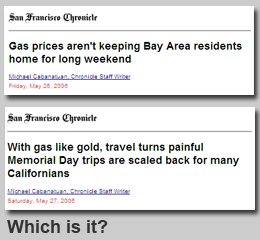May 27, 2006
The Gas is Half Full -- or Half Empty
Few stories produced are hoarier than the ritual holiday travel piece, a slapdash amalgam of quotes from on-the-one-hand-on-the-other "experts," worried or elated industry officials and a random selection of ordinary people who happened to be pumping gas or standing in a ticket line when a reporter and a photographer showed up.
 They are the worse sort of tired, cliché-ridden journalism, emblematic of all the rote thinking that not only wastes valuable newsroom resources on copy designed to fill white space but too often also has the unintended result of confusing the very person the paper is supposed to be informing - the reader.
They are the worse sort of tired, cliché-ridden journalism, emblematic of all the rote thinking that not only wastes valuable newsroom resources on copy designed to fill white space but too often also has the unintended result of confusing the very person the paper is supposed to be informing - the reader.
As the Memorial Day weekend begins, these stories proliferate like May flowers. It is almost unfair to pick on individual papers, but let's do it anyway.
The inspiration for this post arrived with today's New York Times and San Francisco Chronicle. Scanning their front pages at the breakfast table, two headlines caught my eye:
![]() Gas Prices Aren't Deterring Summer Travelers - the Times
Gas Prices Aren't Deterring Summer Travelers - the Times
![]() With gas like gold, travel turns painful / Memorial Day trips are scaled back for many Californians - the Chronicle
With gas like gold, travel turns painful / Memorial Day trips are scaled back for many Californians - the Chronicle
Hmmm. So people are traveling more, according to the Times headline, or less, according to the Chronicle. Confusing. Let's read the stories (emphasis added):
"A new survey predicts that even more Californians plan to hit the road this weekend on trips of 50 miles or more. But while the number of motoring travelers is increasing, many Northern Californians say that gas prices at $3.25 a gallon are forcing them to stick closer to home." - the Chronicle."People are not going to cancel their trips, but what they might do is modify them," said Cathy Keefe, a spokeswoman for the Travel Industry Association. "Instead of taking three or four trips over the summer, people will look for ways to save money, such as staying closer to home." - the Times.
Aha. People are actually driving more, but not as far, according to the Times and the Chronicle.
But if the stories say the same thing, why are the headlines different? Let's double check that on the web. Here's a headline from the Chronicle on Friday:
Gas prices aren't keeping Bay Area residents home for long weekend - the Chronicle.
Wait a minute, that Chronicle's Friday story - posted on its web site mid-afternoon - is the same as its Saturday story - printed in the newspaper, but with a headline that is almost 180 degrees different. Here they are again, same story, different heads (see image, left):
Friday: Gas prices aren't keeping Bay Area residents home for long weekend
Saturday: With gas like gold, travel turns painful / Memorial Day trips are scaled back for many Californians
A scan of Google News or the Newseum's newspaper front pages produces a plethora of similar wishy-washy stories - maybe this, maybe that, could be, possibly, who knows? Hardly at all useful use of reporter time or newsprint. Here are a couple of examples:
Holiday weekend is still a gas / Despite cost of fuel, travel experts expect increase in road trips - Corpus Christi Caller-Times
On the road again -- but not very far - Santa Barbara News Press
Costs up, but people still travel for holiday -- Sioux City (Iowa) Journal
Drivers, start your engines / Record gasoline prices not keeping millions from yearly ritual - San Diego Union-Tribune (on the N.Y. Times story)
And, possibly the most honest:
Analysts up and down about holiday weekend gas prices - Palm Beach Post
Nearly every story I saw was based in part on a AAA press release. Why turn this equivocal drivel into a story at all? It's a box in the paper with prices, data and numbers. On the web, it's links. Five minutes work and move on to something better - something unique, something the paper and the staff hasn't done 150 times before.
Clichés kill. They kill good writing, They kill good ideas. They kill innovation. They are killing newspaper journalism.
It's time to bury them.
Tags: Journalism, Newspapers, Media
Posted by Tim Porter at May 27, 2006 11:03 AM